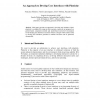105 search results - page 20 / 21 » CHI2006: what is the next generation of human-computer inter... |
ACMDIS
2006
ACM
14 years 3 months ago
2006
ACM
One challenge for ubiquitous computing is providing appropriate tools for professional designers, thus leading to stronger user-valued applications. Unlike many previous tool-buil...
DSVIS
2003
Springer
14 years 2 months ago
2003
Springer
This paper provides an approach to develop user interfaces where plasticity is considered by using several concepts, concretely our proposal is a pattern-based, component-oriented ...
HEURISTICS
2000
13 years 8 months ago
2000
Planning and designing the next generation of IP router or switched broadband networks seems a daunting challenge considering the many complex, interacting factors affecting the p...
ECAI
2000
Springer
14 years 1 months ago
2000
Springer
There are two major approaches to activity coordination in multiagent systems. First, by endowing the agents with the capability to jointly plan, that is, to jointly generate hypot...
ICDM
2009
IEEE
14 years 3 months ago
2009
IEEE
—The real world is composed of sets of objects that move and morph in both space and time. Useful concepts can be defined in terms of the complex interactions between the multi-...

